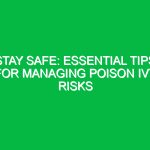Introduction
In the Health, Safety, and Environment (HSE) domain, understanding the definition of a Safety hazard is paramount. A Safety hazard can be defined as any condition, situation, or activity that poses a potential risk of harm or injury to individuals or damage to property. This definition is crucial because it encompasses both physical and psychological factors that can compromise Workplace Safety. By recognizing safety Hazards, organizations can implement preventative measures that protect employees, enhance productivity, and ensure compliance with legal Regulations.
The relevance of safety Hazards in the workplace cannot be overstated. According to the National Safety Council, workplace injuries cost employers over $161 billion annually. This statistic highlights the urgent need for effective safety hazard management. In this article, we will dive deep into the intricacies of safety hazards, explore their definitions, and discuss how understanding these hazards can lead to a safer work environment.
The Key Aspects of Safety Hazards
Types of Safety Hazards
Safety hazards can be categorized into several distinct types, each with its own set of characteristics and implications. Understanding these types is essential for effective risk assessment and management.
- Physical Hazards: These include environmental factors that can cause harm, such as machinery, electrical systems, and noise. For instance, a rotating machine part poses a physical hazard if an employee’s hand gets too close.
- Chemical Hazards: Chemicals can be toxic, flammable, or reactive, leading to health risks. For example, exposure to asbestos in older buildings can cause serious respiratory diseases.
- Biological Hazards: These originate from living organisms, such as bacteria, viruses, and fungi. Healthcare workers, for example, may be exposed to biological hazards through contact with infected patients.
- Ergonomic Hazards: Poor workstation design or repetitive motions can lead to musculoskeletal injuries. An employee who spends long hours at a poorly designed desk may suffer from chronic back pain.
- Psychosocial Hazards: These relate to the mental and emotional well-being of employees, including stress, harassment, or bullying at work. A high-stress environment can lead to burnout and decreased productivity.
Identifying Safety Hazards
Identifying safety hazards is a proactive approach that requires keen observation and thorough analysis. Organizations can adopt several methods to identify potential hazards:
- Workplace Inspections: Regular inspections help identify physical hazards. For instance, a facility manager may conduct monthly walkthroughs to check for unsafe conditions.
- Employee Feedback: Employees are often the first to notice hazards. Encouraging them to report unsafe conditions can lead to quicker resolutions. An anonymous suggestion box can facilitate this process.
- Incident Reports: Analyzing past incidents can reveal patterns and help identify recurring hazards. For example, if multiple slips and falls occur in a specific area, that area may need immediate attention.
Assessing Risks Associated with Safety Hazards
Once safety hazards are identified, the next critical step is assessing the risks associated with them. This involves evaluating the likelihood of an incident occurring and the potential consequences.
- Risk Matrix: Many organizations use a risk matrix to categorize hazards based on their severity and likelihood. This tool helps prioritize which hazards require immediate action.
- Safety Audits: Conducting regular safety audits provides a comprehensive overview of workplace hazards. This process often involves reviewing policies, procedures, and employee Training.
Best Practices for Managing Safety Hazards
To effectively manage safety hazards, organizations should implement several Best Practices:
- Training and Awareness: Regular training sessions educate employees about safety hazards and the importance of adherence to safety protocols. For example, a construction company might hold weekly meetings to discuss safety practices.
- Personal Protective Equipment (PPE): Providing appropriate PPE can mitigate risks associated with specific hazards. For example, Safety Goggles protect workers from eye injuries while handling chemicals.
- Emergency Preparedness: Developing and practicing emergency response plans ensures that employees know how to react in case of a safety incident. Conducting fire drills is a common practice in many organizations.
Regulations and Standards Governing Safety Hazards
Understanding the regulatory framework surrounding safety hazards is essential for compliance and risk management. Various organizations and standards govern Workplace Safety:
- Occupational Safety and Health Administration (OSHA): In the United States, osha establishes and enforces safety standards. Employers are legally required to provide a safe working environment, which includes identifying and mitigating safety hazards.
- International Organization for Standardization (ISO): ISO 45001 is a standard that provides a framework for managing Occupational Health and safety risks. Implementing ISO standards can enhance Workplace Safety and improve overall management practices.
- Local Regulations: Many regions have their own regulations that may impose additional requirements. Familiarizing oneself with these local laws is critical for compliance.
Real-Life Examples of Safety Hazard Management
Real-life examples provide valuable insights into the importance of understanding safety hazards. Consider the case of a manufacturing plant where the management identified the risk of machine entanglement. By implementing safety guards and conducting training sessions, they significantly reduced incidents related to this hazard. Moreover, engaging employees in safety discussions fostered a culture of vigilance and accountability.
Another example involves a hospital where staff reported frequent back injuries due to improper lifting techniques. The management responded by implementing a comprehensive training program on proper Lifting Methods and investing in ergonomic equipment, thereby reducing injury rates significantly.
Conclusion
Understanding the definition of safety hazard is essential for fostering a safe and healthy workplace. By recognizing the various types of safety hazards, implementing effective identification and assessment methods, and adhering to regulations, organizations can significantly reduce risks associated with workplace hazards. The proactive management of safety hazards not only protects employees but also enhances productivity and promotes a culture of safety.
In summary, the commitment to identifying and mitigating safety hazards is not merely a regulatory obligation; it is a moral imperative. Protecting the workforce leads to a more sustainable and productive environment, which ultimately Benefits everyone involved. As we continue to navigate the complexities of Workplace Safety, let us remain vigilant and dedicated to creating safer workspaces for all.
Taking action today can lead to a safer tomorrow. It starts with a clear understanding of what constitutes a safety hazard and the commitment to address it. Protect your workplace today!


